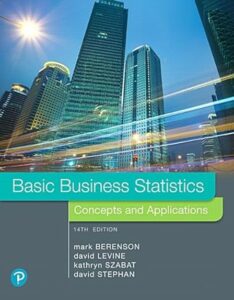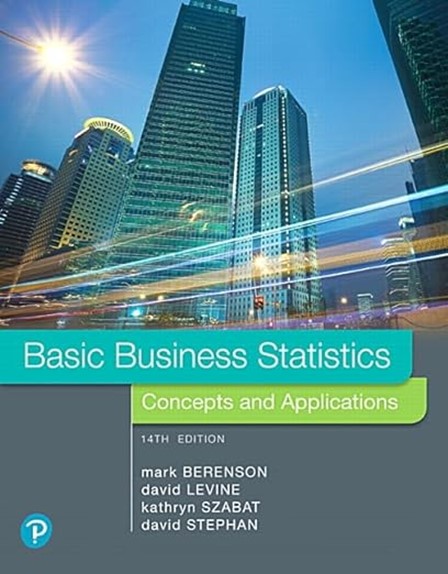BASIC BUSINESS STATISTICS
This book is the result of my working experience in the subject Basic Business Statistics for BBA and MBA students. It is designed to meet the requirements of Bachelors, Masters and Ph D level students. The main highlight of the book is both theory instructor manual and solved problem approach & explanations added for numerical question problems framed by the author. This book has a large number of problems solved in all 11 chapters.
All theoretical concepts needed by students are covered by the author in this book.
I am extremely grateful to all my students who were attentive in the classes when I was conducting the classes.
ABOUT THE AUTHOR
Author’s name is Srinivas R Rao, born and done his school level education in Mangalore, Karnataka in a reputed private school Canara High School and PUC (+2) from Canara PUC in Science stream with PCMB as main subjects.
Later, pursuing LL.B (5 Years) course passed the degree in 1999 and done Diploma in Export Management, Diploma in Customs and Central Excise, Diploma in Business Administration and some important IT subjects like MS- office, Internet/Email, Visual Basic 6.0,C,C++, Java, Advanced Java, Oracle with D2K, HTML with JavaScript, VBScript and Active Server Pages.
Joined as a FACULTY for students in a small computer Institute in 2002 July and later after 4 months worked in a company by name CRP Technologies(I).P. Ltd as Branch Manager (Risk Manager) for Mangalore, Udupi and Kasargod areas from January 26, 2003, to June 11 2007.In the year 2005 pursued MBA distance education course. Currently working as a FACULTY in Sikkim Manipal University, Udupi centre for BBA & MBA students and teaching numerical subjects like Statistics/Operations Research (Mgt Science/Quant. Techniques for Mgt)/Accounting and several numerical and difficult oriented subjects for distance education students in their weekend contact classes from July 2010 till present day.
Thanks
Regards
Author (SRINIVAS R RAO)
CHAPTER 1 Introduction to Statistics
Learning Objectives
The study of this chapter should enable you to:
❖ Define the meaning of Statistics and other popular terms widely used in statistics
❖ Describe the types of statistics—descriptive and inferential
❖ Describe the sources of data, the types of data and variables
❖ Understand the different levels of measurement
❖ Describe the various methods of collecting data
Key Teaching Points
1.1 What is Statistics?
• ‘Statistics’ is a science that involves the efficient use of numerical data relating to groups of individuals (or trials).
• Related to the collection, analysis and interpretation of data, including data collection design in the form of surveys and experiments.
• Defined as the science of:
¤ Collecting
¤ Organizing
¤ Presenting
¤ Analyzing
¤ Interpreting numerical data to efficiently help the process of making decisions
• A person who works with the applied statistics (the practical application of statistics), and is particularly eloquent in the way of thinking for the successful implementation of statistical analysis is called a ‘statistician’.
• The essence of the profession is to measure, interpret and describe the world and patterns of human activity in it both in the private and public sectors.
• Those involved in marketing, accounting, quality control and others, such as consumers, sports players, administrators, educators, political parties, doctors, etc. on the other hand, tend to widely use the outcomes of various statistical techniques to help make decisions.
• Population size refers to a very large amount of data were making a census or a complete sampling of all of the population would be impractical or impossible.
• A sample is a subset of the population.
• Samples are collected, and statistics are calculated from the samples in order to make conclusions about the population.
1.2 Types of Statistics
• Two types of statistics:
1. Descriptive statistics
2. Inferential statistics
• Descriptive statistics explains the sample data whereas Inferential statistics Trieste reach conclusions that go beyond the existing data.
1.2.1 Descriptive Statistics
• Statistical methods used to describe the basic features of the data that have been collected in a study.
• Provide simple summaries about the data and the measures.
• Together with simple graphics analysis, they form the basis of virtually every quantitative analysis of data.
• Use descriptive statistics simply to describe what’s going on in our data.
• Used to present quantitative descriptions in a manageable form.
• Help us to facilitate large data in a way that easily makes sense.
• Each statistic reduces large data into a simple summary.
1.2.2 Inferential Statistics
• Methods used to find out something about a population based on a sample taken from that population.
• Also called statistical inference or inductive statistics.
• Most of the major inferential statistics come from a general family of statistical models known as the General Linear Model
¤ Includes the t-test
¤ Analysis of variance (ANOVA)
¤ Regression analysis
¤ Multivariate methods like factor analysis, multidimensional scaling, cluster analysis, discriminant function analysis, etc.
1.3 Sources of Data
• Two sources of data: ‘primary data’ and ‘secondary data’.
• Researchers conduct various research projects using questionnaires addressed directly to respondents, and their responses are known as the primary data.
• Other studies involving the use of data collected by others, such as information from census and earlier findings are also used by researchers—called secondary data.
• Primary data offer information tailored to specific studies but are usually more expensive and takes a longer period to process.
• Secondary data are usually less expensive to be acquired and can be analyzed in a shorter period.
1.3.1 Primary Data
• ‘Primary data’ is the specific information collected by person who is doing research (researcher).
• Researchers collect data through surveys, interviews, direct observations and experiments.
• Essential to all areas of study because it is the original data of an experiment or observation that has not been processed or altered.
• Primary data can be prospective, retrospective, interventional or observational in nature.
• Prospective data is collected from subjects in real time
• Retrospective data is collected from archival records.
• Retrospective primary data provides information on past circumstances or behaviors.
• Interventional primary data can be gathered after the interventions of interest have been prospectively delivered, manipulated or managed.
• Observational primary data is collected by monitoring an intervention of interest without intervening in the delivery of the intervention.
Advantages:
1 Researchers can decide the type of method they will use in collecting the data and how long it will take them to gather that particular data.
2 Researchers can focus the data collection on specific issues of their research and enable them to collect more accurate information.
3 Researchers would know in detail how the data were gathered and hence, will be able to present original and unbiased data.
Disadvantages:
1 Primary data collection consumes a lot of time, effort and cost; the researchers will not only need to make certain preparations, in addition, they will need to manage both their time and cost effectively
2 Researchers will have to collect large volumes of data since they will interact with different people and environments; also, they will need to spend a lot of time checking, analyzing and evaluating their findings before using such data.
1.3.2 Secondary Data
• Any material that has been collected from published records, such as newspapers, journals, research papers and so on.
• Sources of secondary data may include information from the census, records of employees of a company, or government statistical information such as Malaysia gross national income (GNI) in different sectors and many others.
• Easily available and cheap.
• Available for a longer period of time.
Advantages:
1 Using data from secondary sources is more convenient as it requires less time, effort and cost.
2 Secondary data help to decide what further research need to be done.
READ MUCH MORE INSIDE…
“BASIC BUSINESS STATISTICS”


Your name and email will Never be shared, sold, or given to anyone.
We keep our subscriber’s privacy sacred. We do not sell or rent your personal information to other parties. What’s more you can always unsubscribe at any time!
If for any reason you decided within 30 days that “BASIC BUSINESS STATISTICS” isn’t for you, simply notify us by email and we’ll gladly refund your money – no questions asked. That’s our Ironclad Guarantee! The risk is entirely ours! You absolutely have nothing to lose!
Warm Regards, Coyalita
Copyright © 2021 – 2024 U.S.A. Ads Coyalitalinville.com All Rights Reserved Privacy Policy – Earnings Disclaimer – Terms of Use – Contact Us
